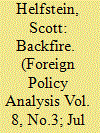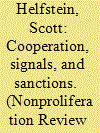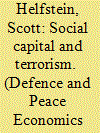|
|
|
Sort Order |
|
|
|
Items / Page
|
|
|
|
|
|
|
| Srl | Item |
| 1 |
ID:
114132


|
|
|
|
|
| Publication |
2012.
|
| Summary/Abstract |
States attempting surprise attacks usually achieve tactical success in catching an opponent unprepared. Many studies of surprise do not look beyond the opening bolt from the blue to examine the impact of surprise based on the broader strategic objectives. A comparative case study of centrally planned surprise attacks from 1950 to 1990 suggests that surprise rarely achieves strategic ends. They did not deter the targets from military action, and more surprisingly, did not contribute to less deadly wars. This runs counter to conventional beliefs about surprise, since attacks are supposed to impair a target's desire or ability to mount a military response. Instead, the most damaging surprises are followed by particularly bloody conflict, a phenomenon referred to here as backfire. The article examines a number of possible strategic explanations for this empirical pattern and ultimately concludes that behavioral decision-making processes characterized by prospect theory offer the best possible explanation. An increased propensity for risk, resulting from the losses suffered during a large surprise, drives target military reaction despite the lower likelihood of success.
|
|
|
|
|
|
|
|
|
|
|
|
|
|
|
|
| 2 |
ID:
091670


|
|
|
|
|
| Publication |
2009.
|
| Summary/Abstract |
This paper uses game theory and modeling to address the role of incentive structures and information dynamics in nuclear inspections. The traditional argument is that compliant states should be willing to allow inspections to prove their innocence, while proliferating states are likely to impede inspections. This argument does not take into account the historical variation in inspection, signaling, and sanctioning behaviors. Using a game theoretic analysis and model, it is shown that the separation of proliferators from nonproliferators only occurs when the likelihood of proliferation is high and punishment costs are moderate. The model assumes that states can choose how much to cooperate with inspectors and must pay opportunity or secrecy costs when inspections are effective. The results are tested against a set of real-life cases, providing support for the claims of historical variation and the model's deductive propositions
|
|
|
|
|
|
|
|
|
|
|
|
|
|
|
|
| 3 |
ID:
107970


|
|
|
|
|
| Publication |
2011.
|
| Summary/Abstract |
The concept of networks has become synonymous with terrorism in recent years. Despite the abundance of material engaging the concept of terrorist networks, there is a paucity of research that applies analytic network methods to the empirical study of observed data. This article fills that void by comparing two arguments about terror network structure using a newly released attack network data set. One account suggests that terrorists purposefully structure their networks to maximize operational security (OPSEC) by minimizing connections, while an alternate proposition relies on findings in network sciences showing that many networks have a few well-connected individuals (referred to as scale-free structure). Empirical analysis of six evolving attack networks produces results contradicting both assertions. This article then looks beyond structure to examine whether there are any causal relationships between network characteristics and output, specifically attack casualties. The article concludes by examining possible drivers of network structure and pertinent policy implications.
|
|
|
|
|
|
|
|
|
|
|
|
|
|
|
|
| 4 |
ID:
096656


|
|
|
|
|
| Publication |
2010.
|
| Summary/Abstract |
Scott Helfstein examines the efficacy of economic sanctions as a tool to counter nuclear proliferation. He argues that contrary to conventional wisdom, international cooperation is not a key determinant in sanction success. Instead, empirical evidence shows that sanctions have been effective at altering nuclear policies only when the sanction sender and target have had friendly relations.
|
|
|
|
|
|
|
|
|
|
|
|
|
|
|
|
| 5 |
ID:
130403


|
|
|
|
|
| Publication |
2014.
|
| Summary/Abstract |
Many studies of terrorism explain the use of violence against civilians with political or economic forces, often relegating social variables to the margins. Social factors, specifically societal-level social capital, play a far more important role in explaining patterns of terrorist activity than previously recognized. Social capital can exert pressures that act as both restraint and catalyst for terrorism, making explicit exposition of these differential effects critical. Analysis shows that higher stocks of social capital positively correlate with the number of terrorist groups, but the average attack activity of those groups increase as measures of social capital decline. The complex relationship makes it difficult to draw simple policy implications, but it does offer insight into the role that social dynamics play in terrorist activity.
|
|
|
|
|
|
|
|
|
|
|
|
|
|
|
|
| 6 |
ID:
106580


|
|
|
|
|
| Publication |
2011.
|
| Summary/Abstract |
While experts understand that Al Qaeda's attack patterns and operational qualities are changing, they struggle to identify and generate consensus on Al Qaeda's strategic center of gravity. By defining different levels of Al Qaeda, core, periphery, and movement, this article engages current debates about the threat by focusing on the operational differences across these three levels. Contrary to conventional wisdom about operational efficiency, the social movement has a higher success rate but the core imposes greater costs as measured by casualties. The cells or networks actually executing the attacks also display substantive differences. The social movement networks organize in smaller cells than either affiliated groups or the core; however, they display greater levels of connectedness. The affiliated and organization cells display fewer connections, suggestive of more disciplined operational procedure despite lower success rates. These patterns reflect fundamental differences across characterizations of Al Qaeda, and have significant implications for counterterrorism efforts.
|
|
|
|
|
|
|
|
|
|
|
|
|
|
|
|
| 7 |
ID:
091064


|
|
|
|
|
| Publication |
2009.
|
| Summary/Abstract |
This article was written at the request of the Secretary of Defense Task Force on DoD Nuclear Weapons Management. While this analysis suggests that certain types of terrorists can be deterred from certain types of attacks, it is less optimistic about the use of nuclear weapons in a terrorist deterrent strategy. A broad approach to deterrence may be effective against certain types of terrorist groups and attacks, making it crucially important to disaggregate the terrorist threat when setting policy. The article goes on to address two types of terrorist groups with a "global reach" that pose a serious threat to the United States: non-state actors driven by doctrines permitting catastrophic attacks and state-sponsored groups capable of carrying out catastrophic attacks. The analysis reveals a number of previously unappreciated tradeoffs and paradoxes associated with the deterrence of terrorists.
|
|
|
|
|
|
|
|
|
|
|
|
|
|
|
|
|
|
|
|
|